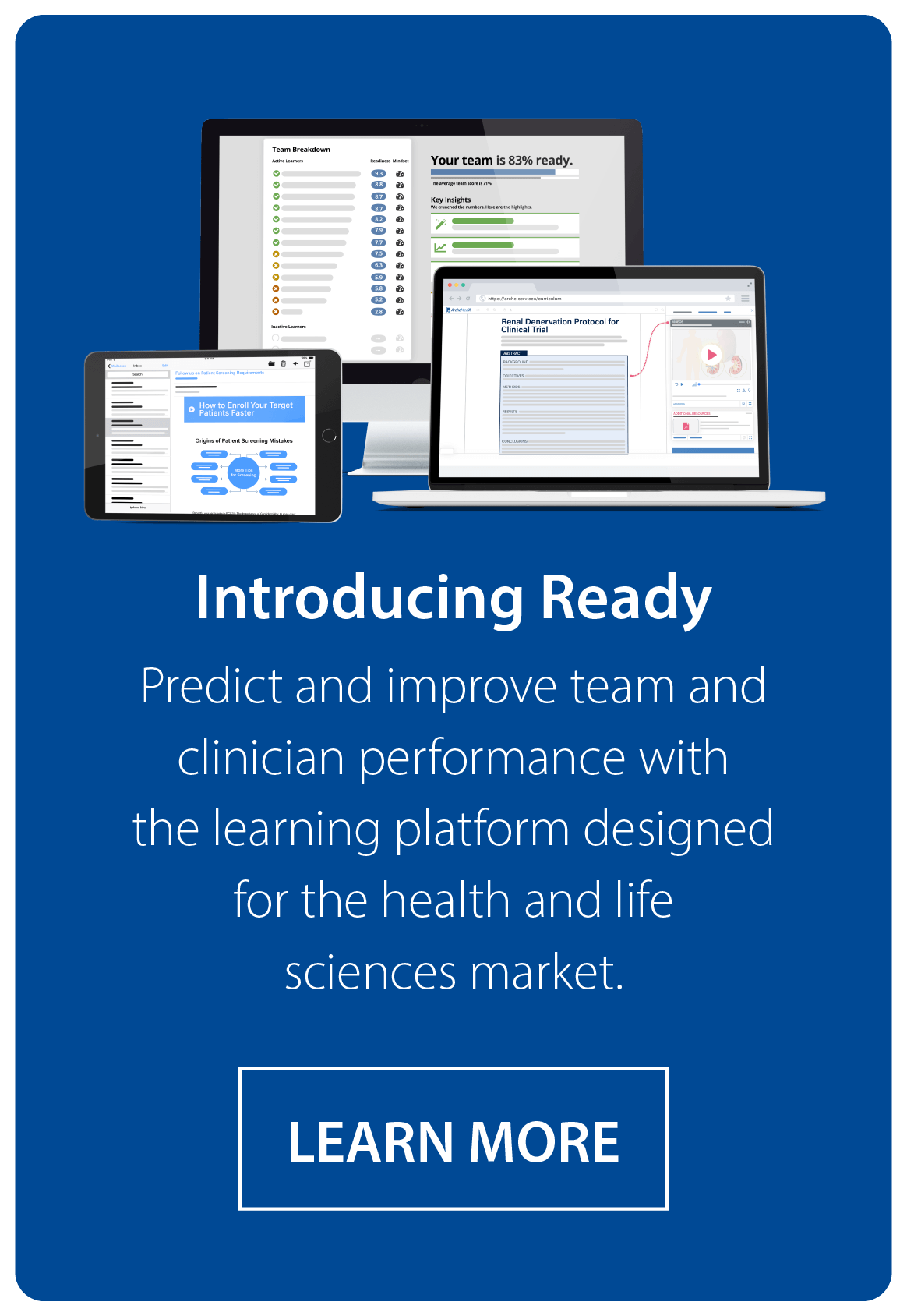Increased diversity. Faster enrollment. Reduction in costs. These are just a few of the myriad benefits of the virtual clinical trial touted by CROs and solution providers. But are you ready for a truly virtual clinical trial? If not, is a hybrid clinical trial realistic? And what is a decentralized clinical trial – how is it different?
There’s no doubt that these and many other benefits are possible results, and even likely ones. If you’ve ever wondered how to even get started with one of these promising new trial designs, read on for our introductory primer.
First, why are there so many new clinical trial designs?
It may feel confusing why the industry is using so many different terms to discuss what seems like one main idea: shifting many of the traditional in-person activities in a clinical trial to digital or virtual ones.
But two things are at play.
First, it’s not one main idea that’s up for discussion. The push towards virtual, hybrid, decentralized, and siteless clinical trials stems from a lot of challenges that plague clinical research:
- Difficulty in reaching patient populations that don’t live close to existing study centers
- Skyrocketing costs of clinical research (much of it in site costs)
- Manual data collection despite availability of new technology
- High early termination and/or discontinuation rates because of perceived burden
I could go on, as there are many more challenges.
But the second factor is the obvious fact that COVID-19 all but halted most in-person activity in 2020. Thus, we pressed forward with innovations. Because the industry accelerated so quickly, we just haven’t had the time or maturity to settle on one concept.
What we’ll uncover in this post is that each of these terms actually are three discrete concepts. Though different, they each present a need for clinical operations leaders to find new ways to train caregivers and study participants in new ways and at scale – so that they will be ready to perform in their now virtual role.
So let’s dig into each of the predominant trial designs. And more importantly, see what they mean for you.
So, what is a Virtual Clinical Trial?
Let’s get this part out of the way: there is no “industry-accepted” definition of what a virtual clinical trial is.
Very broadly, you see the term used to describe clinical trials that replace much – or all – of the in-person clinical trial activities with similar activities conducted through software tools, wearable technology, or some other digital means.
The FDA hasn’t released a clear definition, either. But it was the FDA’s guidance at the beginning of the COVID-19 outbreak that really launched the topic to a trend.
Want to try the free learning activity that covers the FDA’s guidance? Click here.
But with limited clear direction, we now see confusion about the multiple terms used, and what they mean.
How much technology must be used for a clinical trial to be considered a virtual clinical trial?
The most strict definition: A fully virtual clinical trial.
The strictest interpretation of the term is also the easiest to classify. A fully virtual clinical trial is one that is completely technology-based. That means there are no traditional sites, no physical locations used, and no face-to-face interactions.
In short, everything is completely virtual:
- Study start up – no face-to-face meetings, no site visits
- Patient enrollment – completely digital
- Patient treatment – no clinic visits, all done remotely
- Data collection – fully automated via phones, apps, watches, and e-diaries
- Testing, imaging, outcomes – are all digital touchpoints
All clinical trial activities are managed centrally. While interesting, this trial design poses some major challenges because of the availability of – or familiarity with – the necessary technologies. And availability of wearable tech, though on the rise, may be an accessibility concern for some populations.
And in this interpretation, there is no patient and caregiver interaction – only data movement. This creates an additional obstacle for the already difficult recruitment and enrollment process. The perceived benefit of additional, or more personal care drives some participants to join a study.
Further, some demographics could feel uncomfortable with the lack of caregiver contact. And we can’t discount the importance of the personal relationships that frontline caregivers provide to patients. Without them, retention could also decline.
But as noted in a recent ClinicalLeader article, there’s some disagreement in the market about that point. Does a virtual trial mean that patients and caregivers can still interact, albeit virtually? Or does it preclude participant and caregiver interaction altogether?

The most realistic definition: Nearly all trials today are at least partly virtual clinical trials, because they are technology-enabled.
The broadest interpretation of the term virtual clinical trial, though not accepted, is what reflects reality today. Technology enables or assists most – if not all – clinical trials today. It often replaces what was once an interaction between a study participant and a caregiver.
And when someone talks about a virtual clinical trial, it’s often the more realistic definition. While there are some who are pushing for the fully digital, no-interaction trial, most CROs use the term “virtual clinical trial” interchangeably with something else – the “decentralized clinical trial.”
So then what is a Decentralized Clinical Trial?
Helpfully, the FDA has given more guidance on the topic of the decentralized clinical trial.
By the FDA’s definition, it’s the operations of a clinical trial that are being decentralized, using technology to communicate with study participants and to collect data.
While decentralized clinical trials are also virtual by necessity, the model centers on removing the burden of travel placed on patients.
Decentralized clinical trials shift the locus of the research.
It’s well-documented that most patients don’t live near a traditional research site. Decentralized clinical trials move the research out of the central study center and closer to those patients. That could be their homes, or their local community’s doctor’s office.
Though all the activities of a decentralized clinical trial are conducted remotely, and away from central study sites, they don’t have to be fully virtual.
In fact, by partnering with community doctors and even mobile health networks, caregivers are able to perform patient treatments in person. Doing so, however, still requires the support of virtual technologies, like:
- Remote learning on the clinical trial protocol for practitioners and caregivers.
- Digital transmission of data and collected outcomes.
- Virtualization of patient enrollment and other processes.
The greatest benefit of decentralized clinical trials is reducing the burden of the patient. That opens up great opportunity for diversifying patient participant and caregiver populations across race, culture, language, and regional barriers that exist.
Decentralization introduces new obstacles.
But even with a highly-engaged patient population, and with the best virtual plan, some obstacles remain:
- Decentralized clinical trials are not ideal for every clinical protocol, especially those that require specialized treatment or testing.
- They also require education-at-scale for any caregiver or practitioner that will service patients during the trial. Without a plan for asynchronous learning and automated communications, this stretches resources.
- Management of patients and investigational product has to be planned well to ensure adherence.
- Data has to be collected in a way that is both reliable and scalable. Decentralization means that clinical operations must expand and simplify data collection to allow many more entry points, by more individuals – some of whom may lack experience, or be doing so for the first time.
But now is a great time for trial sponsors to find solutions to these challenges. Telemedicine services, the acceptance of consumer-grade wearable sensors as reliable, new providers of mobile lab services and IP delivery, and on-demand learning tools like Ready for training-at-scale mean decentralization is more realistic than ever.
Get a demo of Ready, the only learning and analytics platform designed to improve performance and enable digital clinical trials.
With the right structure and a well-thought out plan, a decentralized clinical trial becomes very attractive. Today, CROs compete to build centers of excellence, even if they lack experience to support the demand.
But are they realistic for your trial – today? It’s unlikely, but that is why yet a third term has entered the nomenclature: the hybrid clinical trial.
What is a Hybrid Clinical Trial?
If your upcoming clinical trial is simple, and doesn’t require any face-to-face visits, a virtual design may be ideal for you.
If your trial demands diverse patient populations, and you’re well-equipped to educate individual care providers to deliver your investigational product, you might strongly consider a decentralized trial design.
But what if you see some opportunity for your trial, but still need some central sites? Or still require at least one in-clinic visit because of procedures or special tests?
This is the most common scenario for upcoming trials today, and it’s why I led with the idea that we should consider nearly all clinical trials “partly virtual.” In the strictest sense, though, they’re known as “hybrid clinical trials.”
Today’s hybrid clinical trial designs are part of the catalyst for technology adoption. That is:
- Use of consumer-grade wearable tech with trial site validation paves the way for greater confidence that it is reliable.
- Delivery of CRA content on learning platforms by major CROs like PRA is what proves on-demand learning will work to train trial teams at scale.
- Mobile technology used by traveling phlebotomists and home nurses establishes a precedent that can reach underserved areas fast.
Even the FDA appears to be open to the opportunities of the hybrid trial design. The organization included the study design in its RWE framework as early as 2018. And after the COVID-19 outbreak reached the US, it issued new guidance establishing its openness to new technology adoption to keep clinical research going in an unprecedented time.

Virtual vs. decentralized vs. hybrid?
So, what term should we use? In short, all of them.
Each trial design offers specific benefits and challenges to upcoming clinical trials today.
Some areas of clinical research are not ready for remote monitoring and full decentralization. Many trials have some nuance that renders them too complex to remove human supervision from the protocol.
Telemedicine, while on the rise, doesn’t drive the same confidence as a face-to-face visit for some patients – at least not yet. And it’s not suitable for all trials, because of potential reactions, adverse events, or sophisticated equipment necessary for monitoring.
For most clinical trials beginning today, only the hybrid clinical trial model describes a suitably flexible scenario that accommodates any level of technology enablement. Most – if not all – clinical trials today qualify as hybrid trials.
Your study protocols today can mix and match centralized and decentralized tools and processes based on your specific study objectives. For example:
- Using Ready by ArcheMedX to train sites in a traditional Phase II trial, and then again to train your global team in your Phase II or III decentralized clinical trial.
- Adopting wearable technology to reduce – but not yet eliminate – the burden of site visits for patients.
- Partnering with mobile caregivers to simplify some treatments for the most vulnerable patients.
While you build your capabilities to embrace a virtual future, take advantage of the tools available today. Many, like those above, can deliver immediate value to you regardless of how virtual or decentralized your next hybrid clinical trial may be.





